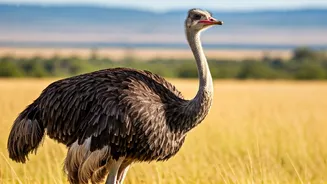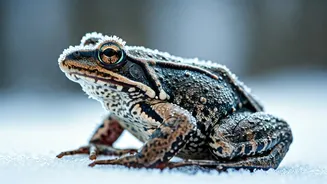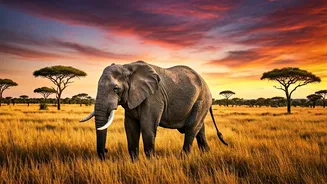Giants of the Sky
The ostrich, scientifically known as *Struthio camelus*, holds the prestigious title of the world's largest living bird. They can reach impressive heights,
with males often standing over 9 feet tall, a height that’s undeniably impressive in the animal kingdom. Their weight also matches their size, with mature ostriches weighing upwards of 300 pounds. This substantial size presents challenges and advantages, dictating how they interact with their environment. Their sheer size is a crucial factor in both their survival and their evolutionary trajectory. This physical dominance is a significant aspect of their survival tactics.
Powerful Defensive Kicks
Ostriches possess incredibly powerful legs, a defense mechanism that is arguably their most formidable weapon. They have the ability to deliver a kick that can be lethal to predators, a testament to their physical strength. The force behind an ostrich kick is astonishing, capable of inflicting severe injuries on even large animals, including potential life-threatening injuries. This formidable kick is delivered with a downward motion. It is crucial to remember that ostriches won’t usually attack unless they feel provoked, using this power only when necessary for self-preservation, which highlights their complex nature as animals.
The Strong Stomach
The ostrich's digestive system is specifically adapted to consume a wide range of foods, including tough plant matter and even small stones. These stones help the bird grind down food in their gizzards, which helps with digestion. This strong digestive system allows them to thrive in varied environments where other animals may struggle to find sustenance. This remarkable adaptation is key to their survival, contributing to their ability to adapt and prosper in diverse habitats. Ostriches are not picky eaters, and this adaptability is essential for their survival.
Two Distinct Species
There are actually two recognized species of ostrich, although the differences between them are quite subtle. The common ostrich (*Struthio camelus*) is the most widespread and well-known, found across Africa. A lesser-known species or subspecies can sometimes be observed within certain regions. These two species have variations in their plumage, size, and geographic distribution. These differences have occurred due to their evolutionary paths, as they have adapted to different environments. Genetic studies and ongoing research continue to refine the understanding of these two distinct ostrich species.
Social Butterflies
Ostriches are inherently social creatures, preferring to live in flocks rather than in isolation. These flocks typically consist of between 5 and 50 individuals, providing a crucial sense of security and enhancing their survival in the wild. Being part of a flock allows for more effective predator detection through shared vigilance. This social structure also promotes cooperative behaviors like foraging and defense, which contributes to the overall well-being of the group. This social behavior is an important aspect of their daily lives.
Impressive Mating Dances
During the mating season, male ostriches engage in elaborate displays to attract potential mates. The male's dance involves a series of dramatic movements, including wing flapping, head bobbing, and vocalizations. This dance is not merely for show, as it also serves to signal the male’s fitness and dominance within the group. The more impressive the display, the higher the chance of attracting a mate. Their elaborate displays are very different. The male also prepares a nest to entice females. This is a very interesting scene to watch.
The Head-in-Sand Myth
One of the most persistent myths surrounding ostriches is that they bury their heads in the sand when threatened. This, however, is not the case. The actual behavior behind this myth comes from ostriches lying low to the ground to blend in. The myth likely originated from the ostrich's habit of lowering its head and neck to the ground to eat or to dig nests in the sand, giving the appearance of burying their head. While they do not actually bury their heads, they sometimes rest their heads close to the ground to listen for predators or during nesting. This misconception is a lasting testament to the human fascination with this unique animal.
Flightless Speedsters
Although they can’t fly, ostriches are incredibly fast runners, and this is their primary defense against predators. They can reach speeds of up to 45 mph, making them some of the fastest animals on two legs. This speed allows them to outrun many of their natural enemies, granting them an effective means of escape. Their powerful legs and streamlined bodies are perfectly adapted for speed, which allows them to traverse vast distances and escape predators quickly. They are, in essence, built for speed and endurance on the ground.
Two Toes Per Foot
A peculiar characteristic of the ostrich is that they have only two toes on each foot. This is unique among birds, which typically have three or four toes. This adaptation is a key part of their running ability, giving them increased stability and traction at high speeds. The large size of the two toes provides the necessary balance and propulsion to support their weight. This feature is directly related to their adaptation for a terrestrial lifestyle and provides significant advantages in their environment. This is just one of the things that make the ostrich so unique.
Giant Eggs
Ostriches hold the record for laying the largest eggs of any living bird. An ostrich egg can weigh up to 3 pounds and is roughly equivalent to two dozen chicken eggs. These large eggs provide a substantial food source for both the ostrich chick and, potentially, other animals when abandoned. The size of the eggs is a testament to the ostrich's large size, and the energy needed to produce them. The chicks develop in these massive eggs, which provide a large start for these flightless giants, contributing to their survival.






